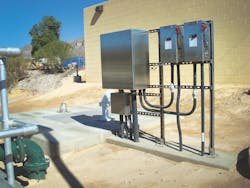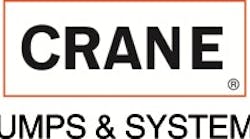The town of Hayden is a small, tight-knit community in southeastern Arizona with a population of 700 people that is almost entirely housed within approximately 1 sq mile. Everyone knows everyone. The town has close ties to the copper mining industry—the principal funding and source of economy for the town is the copper mines. The topography of the town is hilly and mountainous.
Environmentally Responsible
The municipality of Hayden has been purchasing Barnes pumps for the past 18 years from Pump Systems Inc., Crane Pumps & Systems channel partner, of Gilbert, Ariz. The municipality was one of only two in the state that did not have a wastewater facility or infrastructure for wastewater disposal. The raw sewage was being pumped up onto the mines’ tailing piles, and the water that would run off was recaptured and reused by the mines.
There was an environmental concern due to the lack of treatment of the raw sewage. Mark Reynoso, crew leader for the municipality, described the process as “inexpensive to operate, but not a proper infrastructure for wastewater.” Concerns with this method were continuously growing.
In 2012, the municipality decided that a proper wastewater treatment plant needed to be built to ensure that reused water could be treated. The construction of the new wastewater treatment plant was completed in five phases in just more than two years. The municipality had a long track record of success with Barnes SE Series non-clog pumps due to their life expectancy, availability and pricing. The project engineer specified these pumps.
The project design included strategically placed lift stations throughout town, with the wastewater treatment facility constructed on the south side of town at the lowest elevation point. The plant has a capacity of 80,000 gal per day (gpd) on average and 200,000 gpd peak daily flow. The plant was built on 2.21 acres.
Selecting Technology
Gary Cruz, operations supervisor for the town of Hayden, met with David Donovan of Pump Systems Inc. to decide which pumps would best serve the town.
When selecting solids-handling pumps, it is important to understand the flow and head requirements of the application. Pump requirements are based on the peak inlet flow to the station during a day’s time. The actual flow, known as diurnal flow, varies by time of day, and each is unique; frequently, there are two or three peaks within a 24-hour period.
After reviewing the town’s requirements with the engineer, the Barnes solids-handling series was selected: eight 4SE, four 3SE and two 4SHV. The SH Series provides 3-in. solids handling capability. The 4SE pumps are installed inside the plant and the 4SH pumps are being used after treatment to move the reused water.
“We’ve tried other pumps, but we just didn’t get the life expectancy out of them,” Reynoso said. ”We have a couple of Barnes pumps that are more than 15 years old; we’re not going to change what we’ve been doing.”
Simplified Operation
Modernized lift station and pump designs made for a smooth installation process. The pumps can be removed via breakaway fittings, as opposed to maintenance workers going down into the wet well.
A breakaway fitting consists of a base elbow and slide rail adapter with brackets and hardware that allow for the pumps to essentially slide up and down the rails, providing easy installation and removal of solids handling and sewage ejector pumps in permanent wet well installations. The pumps do not need to be unbolted, keeping operators out of the lift station. They have a plug-and-play cord that allows easy changes of both voltage and cord length without motor entry.
“I love the idea of the cord being able to plug in and remove from the pump. I will no longer have to go through the aggravation of fishing wire through the conduit,” Reynoso said. Epoxy paint provides external corrosion protection.
The community is seeing benefits in the mines, having easier access to disinfected water. The effluent water is pumped back to the mine and is being reused properly. There have been no clogs in the lift station pumps since installation.
The municipality currently monitors the pumps through control panels with moisture and overload sensor relays. Whenever there is an issue, a light on the control panel goes on. The municipality soon will be equipped with wired real-time computer monitoring so that a message is sent to the operator’s phone; therefore, by time the team gets to the problematic lift station, the issue is known and they can immediately start working on the solution.
Download: Here


